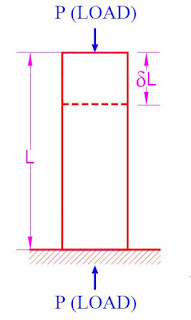Consider a vertical bar
of length ‘L’ and cross sectional area ‘A’ fixed at its bottom as shown in
above image. Let a downward axial load, P is applied at its top (free end). The
support at bottom now offers an upward reaction equal to P and keeps the bar in
equilibrium. Now the applied load tends the bar to shorten by an amount ‘δL’.
This load which causes shortening of the member is termed as a compressive load
and the member is now said to be in compression.
Now, the internal stress developed in the bar (P/A) due to
this compressive force is called the compressive stress (ϭc) and the
corresponding strain in the bar (δL/L) is called the compressive strain.
It is now seen that compressive stress and compressive
strain are developed in a member when two equal and opposite axial force act on
it, inwards towards the centre of gravity of member.


No comments:
Post a Comment